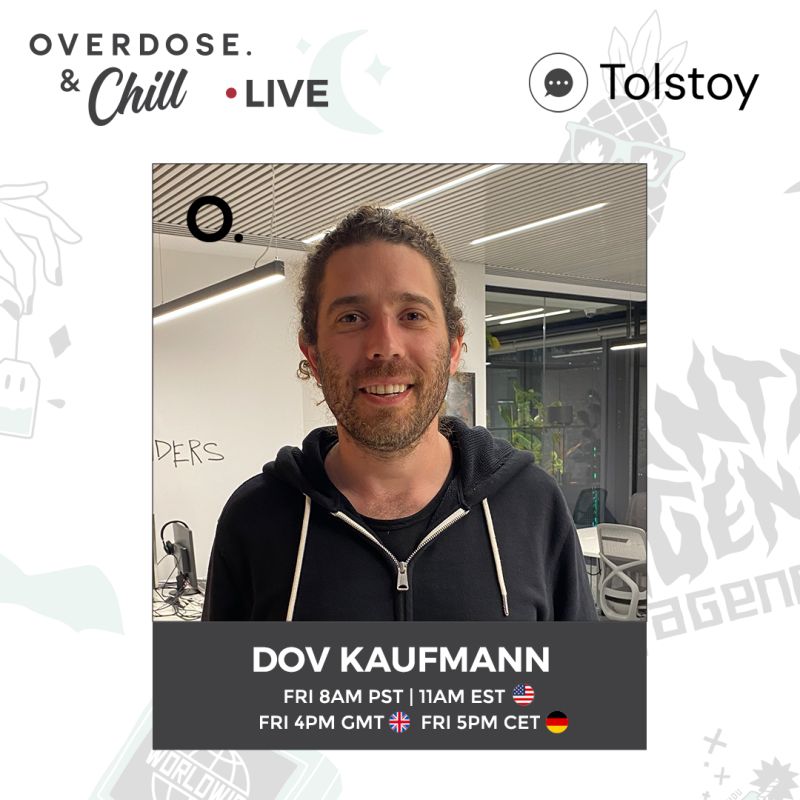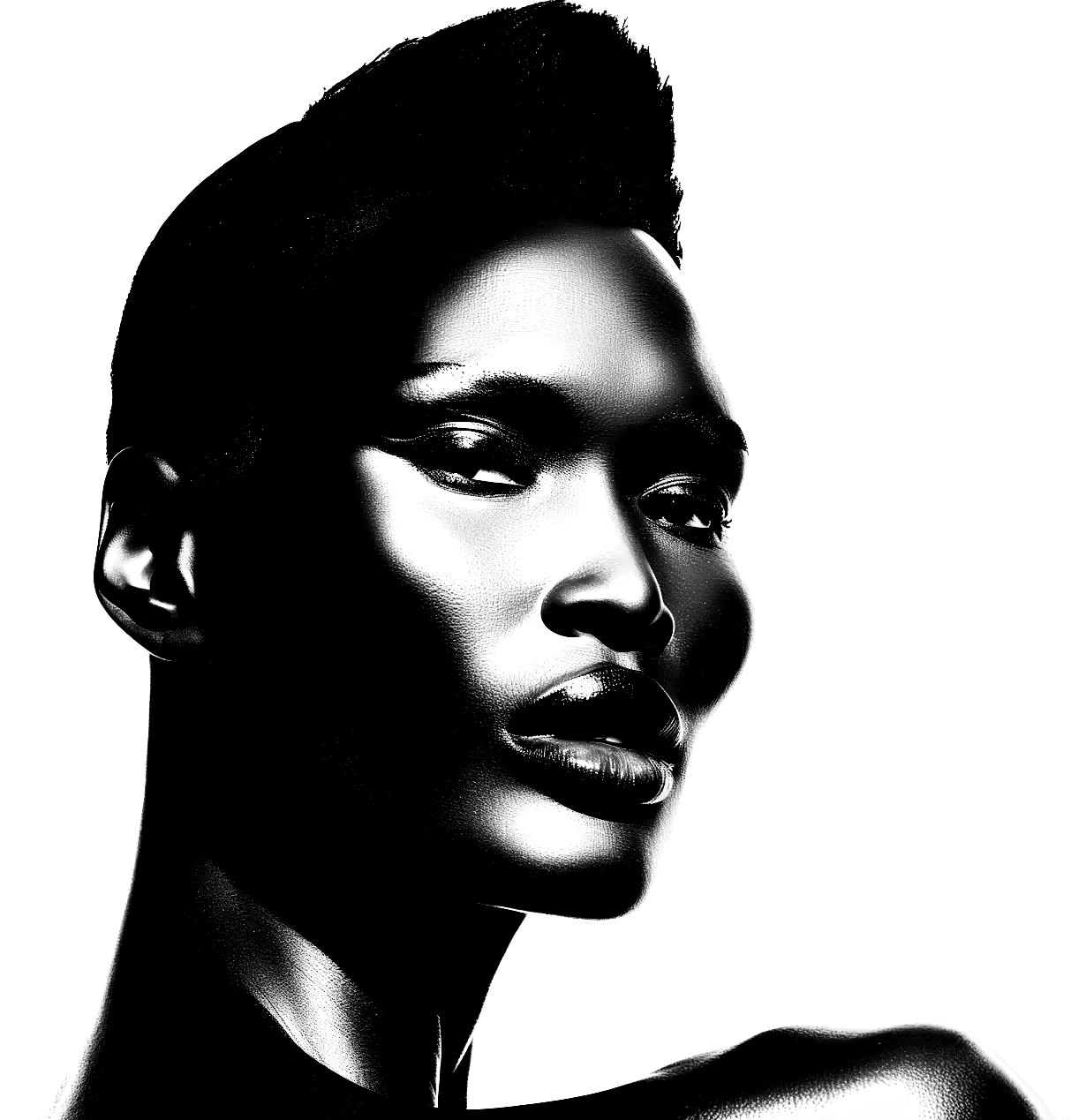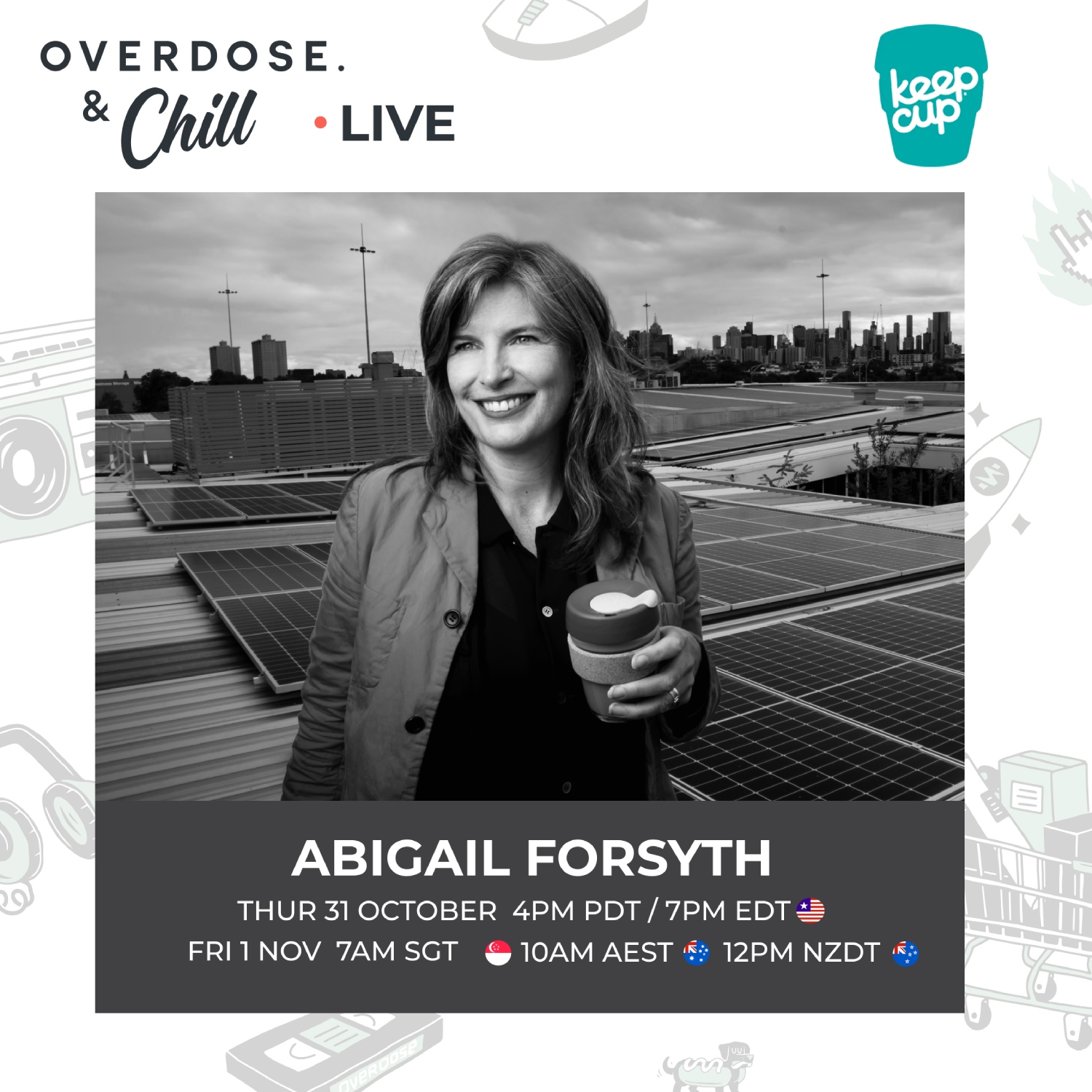

Dov Kaufmann @ Tolstoy
#036 : In this episode of Chill, we chat with the great Dov Kaufmann from Tolstoy. The Co-Founder and CEO of Tolstoy, Dov spent 7+ years as VP of Business Development at Yotpo before embarking on this new venture in 2020.
One of the coolest techs we’ve seen in quite a while, Tolstoy is “next level” when it comes to on-site engagement. Overdose’s Andrew Potkewitz and Dov discuss entrepreneurship, growth, engagement, video journeys, guided selling, and more…
Tolstoy
Video has been a popular play for marketers for a while, but now an even more powerful and persuasive option is becoming the hero: interactive video. Interactive video enables hyper-personalised face-to-face communication, without actually being in person.
A fresh, innovative start-up, Tolstoy, is leading the charge in this ‘next level’ engagement tech space by creating a sophisticated, yet simple and easy-to-use video builder.
The crux of the tech is the fusing of interactive and linear video to create video branching: viewers respond to the Tolstoy video message with clickable on-screen choices which take them on a customer journey based on their needs. The tailored messaging steers viewers to the right content for them.
Described as a chatbot on steroids, a Tolstoy not only grabs user attention, but guides, educates, and qualifies potential customers. It’s cost-effective, technically easy to deploy, and can be embedded in a business’s website, landing page, emails, or used in social media. It sends out a notification to you whenever someone engages with your video, so you can reach out immediately.
To top it all off, Tolstoy enables businesses to collect critical data they would miss with traditional video—providing truly comprehensive marketing intel.
Dov Kaufmann
Dov was employee number nine or ten at Yotpo when it was just getting off the ground. He started in support, then quickly moved into managing events, and then managing business development and starting up the partner team.
By nature of being a people-heavy organisation, Dov says Yotpo was difficult to scale up. “It becomes very, very difficult to manage at scale, and a lot of things, especially in a SaaS company, end up being very repetitive and you’re just having the same conversations with partners.”
The Tolstoy idea came from the pains Dov experienced at Yotpo. He had been thinking for years about whether there was a way to provide the benefit of face-to-face communication in a self-service asynchronous video platform.
Eventually, he made it happen—he jumped out of Yotpo, teamed up with his Tolstoy co-founder, and together, they built the platform to answer those pains. Yotpo became one of Tolstoy’s earliest customers.
Launching Tolstoy during Covid
Just before the arrival of Covid, Dov was grappling with a way to launch Tolstoy; there was some resistance in using video to communicate rather than in-person. Personal connection was preferred—people wanted to meet in person, go to conferences, and so forth.
From an ecommerce perspective, people were used to shopping online from the comfort of their homes or beds—they could do it in their pajamas or their underwear, but the idea of engaging in live video seemed terrifying and far too intrusive.
When a global pandemic came along the option to meet in person was taken away. Instead, we turned on video chat, joined video meeting platforms, and we all became more comfortable interacting over video.
It’s a different world we live in today and people have fewer qualms about being on live video from home. Besides, tech such as Tolstoy is one-way video where you can see them, but they can’t see you. Understanding this creates more ease for users.
So, in the end, Covid’s timing was impeccable for Tolstoy. Dov says it was the push they needed “to actually jump and do this thing.”
Tolstoy for ecomm
Tolstoy was originally designed for SaaS businesses—as a B2B sales tool. It was pitched as a way for companies to have face-to-face conversations with their leads and customers without having to maintain and manage an army of sales reps.
Soon after launching, Dov realised it has ecommerce applications as well. Regardless of whether it’s B2B or B2C, it’s about conversing face-to-face with customers and increasing conversions. Ultimately, it’s a new way to communicate, and it’s already taken off across a number of different verticals.
How brands can use Tolstoy:
- Tell a brand’s individual story and show the people behind it
- Personal shopper – personalised recommendations
- Explain (and show) complex products and product categories
- Recommend bestsellers
- Welcome bot
- Interactive FAQ
- How-to videos
How does it work?
Jump onto Tolstoy and follow a simple step-by-step process:
- Record a few short video clips on your phone. At the end of each clip, you can ask your visitors a question.
- Use the drag-and-drop builder to stitch the videos together.
- Create different flows for each type of customer.
- Embed your Tolstoy anywhere on your site, with the click of a button. You can publish it as a video chatbot, an embedded video, or share it in an email.
- Get notified whenever a visitor engages with one of your Tolstoys.
- Get deep insights about each visitor, and easily create super-smart segmentation.
It’s worth checking out some examples on the Tolstoy website to get a feel for how it all comes together: https://www.gotolstoy.com/our-favourites
Benefits of using Tolstoy
Presenting your brand ambassador…
Businesses can use their Tolstoys as they would a brand ambassador, or an influencer, for guided selling. On the flipside, for the customer, it’s akin to having a personal shopper.
It changes up the chore of reading…
A website full of copy can be tiresome to read—like FAQs for example, so when a Tolstoy is deployed to make content into an engaging interactive video, it’s a better experience.
Getting to the nitty-gritty of what the customer wants…
The customer can be asked by the presenter/brand ambassador/personal shopper a series of questions such as ‘which products are you interested in?’ or, if, say, the product is skincare, ‘what type of skin do you have?’ The questions can be at a basic level, or more in-depth and can home in on pain points.
“You can get really, really deep just as you would in a store or in a conversation and really start to identify who the person is in a really deep way, I think for the first time,” explains Dov.
Tolstoy’s broad customer base
Despite initially setting out with B2B SaaS in mind, once launched, Tolstoy saw a myriad of businesses coming to them all looking to leverage the tech: “There’s no way to classify them, this thing solves a lot of different types of pain points.”
“We haven’t figured out if there is a sweet spot for this,” says Dov, “or is it just a new way to communicate? And just like in communication, you can do anything with it. That’s where we’re leaning after a lot of soul searching about this because we tried to shut out that noise, but we realised this is actually the opportunity to build something super horizontal.”
Use cases
B2B sales: In a B2B setting, the salesperson can pitch to leads like it’s one-to-one, but at scale. The presenter need only record the video once but can send it out to hundreds or thousands of different people. All are having the same conversation, yet it feels personal.
HR: There’s an HR use case—Tolstoy themselves are using it this way. Prospective employees send in videos of themselves using the technology to talk about themselves and present their resumes in a video format.
High ticket items: Tolstoy is gaining popularity with sellers of expensive products—where customers need the personal touch, authenticity, and emotional connection; they feel the need to speak to someone before putting down $3,000, $5,000, $10,000 on a product online.
Guided selling: Take for example, a merchant selling power tools. When you come to the website, the Tolstoy kicks off and asks, ‘Hey, what are you looking for today? Is it drills? Is it saws? Is it something else?’ Or it could be a brand with a ton of different SKUs. Some businesses have tens of thousands of SKUs, and people are confused on the website and don’t know what to buy. Tolstoy can provide a new way to help customers navigate in a guided sell fashion.
And then there are complex products or those that need a lot of education. Merchants may traditionally have trouble explaining how to use the product, what it does, or how it’s different. In this case, customers need someone who’s an expert to walk them through the products and help them find the right one.
Is Tolstoy a complete solution?
The aim is to be as deeply integrated as possible. Ideally, a customer would go onto the Tolstoy and be able to complete the entire experience—view the product, read the reviews about it, make a buying decision, add it to the cart—all within the Tolstoy.
As well as being an engagement platform and a conversion funnel optimisation tool, it’s also a data tool. “We collect really, really deep data about your customers and your leads—data that there’s no other way to get besides getting them on the phone or talking to them in person, which is not always possible,” says Dov.
Once collected, brands can add the data to a CDP, or CRM, or they can use Tolstoy’s CRM, or email marketing tool, and create different kinds of smart segments based on how the users answer or what paths they take.
How does it render?
Dov says it can be any way you can put it as an I-frame embedded. “You can place Tolstoy however you want—we have companies placing us in different pages and in ways that are surprising to us. And then we make that out-of-the-box.”
Tolstoy has been working really well as a pop-up modal, such as being deployed for an exit intent—someone’s about to leave and you can have a Tolstoy person coming up and having a conversation or asking them why they want to leave.
In another use, brands are placing Tolstoys as a hovering widget, similar to a chatbot. Dov explains they don’t have chat capabilities, so it’s never instead of a chatbot—it’s usually either above or below the chatbot or on the other side of the page. It’s calling your attention to it, to have a conversation with you.
How does Tolstoy integrate with other modals and features?
In any given tech stack, there could be potentially 10, 12, or 15 different modals, so it’s good to know Tolstoy is highly integrative—it is designed to seamlessly integrate with thousands of existing marketing tools.
Tolstoy is often placed at the front of the customer journey—as the first thing someone sees—so as to build a personal connection. In this first engagement spot, it helps to identify what the person wants—for instance, do they want to talk to a live rep and do a live selling session, or do they have a chat question or a support question. “We can then open up or they can click to show what they want,” Dov explains, “or they can type it out or they can say it, and then we’ll open up. We’ll disappear and open up the chatbot so that it feels like a seamless experience on the viewer side, but we disappear. We feel like we’ve done our job at that point.”
It’s really just replicating the exact thing that would happen in a physical store. Even at the end, just like a store rep, the Tolstoy can come back and say, ‘Hey, I’m really glad. I hope we answered your question. Do you have any other questions for us? Or do you want me to show you X, Y, or Z? Or do you want me to take you here?’
More ways Tolstoy can add value
Call centers: Tolstoy can potentially help businesses reduce call center volume by providing FAQs and eliminating the need for customers to call.
Video responding: Viewers can respond with videos. For example, when a skincare customer is asked what their skin concern is, the customer can take a quick video of their face.
Post-purchase engagement: While presently Tolstoy is being used mostly at the top of the funnel to drive conversions there is potential for post-purchase engagement, such as driving UGC.
Coming from Yotpo, Dov knows more than anyone, it can be a challenge for a brand to drive UGC. Tolstoy can help out here: “Potentially,” says Dov, “you could send a Tolstoy out post-purchase as well and drive someone to a Yotpo to write a review, or sign someone up to a loyalty program or to the SMS program.”
It’s harder to say no to a person asking you directly than it is to ignore an email.
What challenges did Dov face getting Tolstoy off the ground?
Personal life: One of the biggest challenges for Dov has been finding time for a personal life, “which I don’t have,” he says.
Building the team and the relationships: In the beginning, it was getting to know his co-founder as a partner and building a strong relationship there. Then, as they grew and other people came on board, there were more relationships to build and strengthen. “It’s been a good challenge in the sense that I feel like we’re all growing from it.”
The daily juggle: Building a company from scratch requires doing so many different things at the same time.
Emotional struggle: Emotionally dealing with growing a business is a constant struggle. “I think maybe the biggest challenge is the emotional side, especially in the early, early days—a feeling every day of ‘Is this going to give value? Are we going to be able to raise money? Are we going to be able to do this?’ And just having to take that on.”
As things tracked along in the right direction, ease began to set in. Dov says they started to realise they were providing value, they were able to raise money, and so forth. “It started to make us feel a little bit safer.”
Vetting the initial idea
Back in the beginning, when the initial idea was to automate the sales process by providing a video sales mechanism for SaaS businesses, Dov and his business partner needed to validate their idea before they took it to market.
“The idea was to make the experience for people buying SaaS software a lot more fun because, personally, I don’t like having to get on a demo that ends up being a qualification call with the 20-year-old SDR who I feel knows less than I do about the industry. Just the whole process felt very antiquated.”
To test and validate the idea, they needed to render a complex sales process into an interactive video script. Perhaps unsurprisingly, they used Yotpo as the test case and built out a script. It was much harder than they expected—the script got really complicated and was taking too long.
They finally cracked it after realising they needed to just keep it simple, and not try to replicate a real conversation—make simple paths and keep it structured.
They showed the script to Yotpo, convincing them to try it out—it worked and Yotpo are still using it today; anytime a partner signs up for a demo of Yotpo, they get sent to Tolstoy.
The results for Yotpo have been phenomenal—the Tolstoy conversion rate is higher than a real person can achieve.
What’s Tolstoy’s growth strategy?
The current growth stream is largely by way of visibility on the web—word-of-mouth, funnily enough—brands see other brands using Tolstoy and want to jump on the bandwagon for their own brand.
The other large mechanism for Tolstoy’s growth is partnership building––partnering with shopping platforms like Shopify and with agencies like Overdose. “I think agencies in general are a really, really strong play for us. I think there’s a lot of value for agencies also in managing this process and building the content and managing and optimizing the data and the analytics.”
As a self-confessed conference groupie, Dov says he cannot wait to get back into the conference circuit and showcase Tolstoy to the industry. It’s a somewhat ironic admission, given Tolstoy replaces in-person relationship building, but we think it’s a great thing for humankind that we still sometimes want to be in the same room, not just on the same screen.
It’s a new era of communication and customer engagement, the interactive video space is going from niche to the norm, and Tolstoy is already totally owning it.










.svg)
